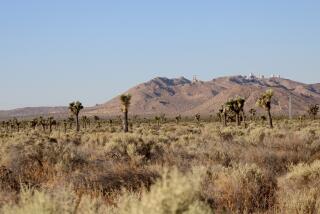Proposed Arizona copper mine may threaten ocelot and jaguar
- Share via
A lone male ocelot has become a symbol of the conflict between conservationists and federal officials over a proposal to build an open-pit copper mine in the Santa Rita Mountains, just south of Tucson.
The discovery of the ocelot in April prompted the U.S. Fish and Wildlife Service to reexamine its 2013 biological opinion that the Rosemont Copper mine would not unduly harm habitat for endangered species in the area, including the only known jaguar in the United States.
The ocelot, photographed with a remote-sensor camera operated by the University of Arizona, is among a handful of the secretive, highly territorial and federally endangered cats that are the first in half a century to prowl so far north of Mexico, scientists say.
There were no ocelots documented in the Santa Ritas when the agency issued its biological opinion on the mine project, proposed by Canadian firm Augusta Resource Corp. The project is to include a 955-acre open pit, a processing plant, transmission lines, new roads and tailings facilities.
Now the agency is weighing whether to anticipate an “incidental take” of an ocelot if the mine is built and trying to determine the company’s potential liability in the event the facility is linked to the death of one of the cats.
To answer those questions, the agency must first determine if the ocelot is a vagrant or a resident and if there are females in the thorny desert region, where federal protections and cattle ranchers are credited with protecting habitat for jaguars and ocelots.
The agency is also reconsidering the potential impacts of groundwater pumping by the mine on critical habitat for the endangered Chiricahua leopard frog and two fish, the Gila chub and Gila topminnow.
Conservationists led by the Center for Biological Diversity, which is based in Tucson, about 25 miles north of the Santa Ritas, have their minds made up.
“The science is clear,” said Randy Serraglio, a spokesman for the center. “The Rosemont mine cannot coexist with jaguars, ocelots and other endangered wildlife whose survival is on the line.
“Beyond that, we may be witnessing the results of the good work the USFWS has done by making it illegal to kill jaguars and ocelots,” he said. “Why would we want to turn our backs on that?”
The project was controversial even before the ocelot showed up.
In earlier drafts of the 2013 biological opinion, agency biologists concluded that the proposed mine would destroy thousands of acres of critical habitat for the jaguar on public land and sever access to the species’ range in northern Mexico.
Steve Spangle, manager of Fish and Wildlife’s ecological services field office in Arizona, rejected his scientists’ conclusion on the grounds that the adverse impacts they predicted were “too speculative” and not “highly probable” to result from the operation.
“The ‘incidental take permit’ we gave the company was based on our conclusion that the jaguar may simply shift its home range elsewhere,” Spangle said in an interview. “We never granted permission to physically harm or kill a jaguar.
“I’m as excited as anyone else that these animals are showing up out there,” he said.
In 2009, the Arizona Game and Fish Department euthanized the last then-known jaguar in the United States after capturing and outfitting him with a radio collar. An independent investigation later determined that the jaguar’s death was due in part to mismanagement by state officials.
Follow me @LouisSahagun for more fascinating stories







